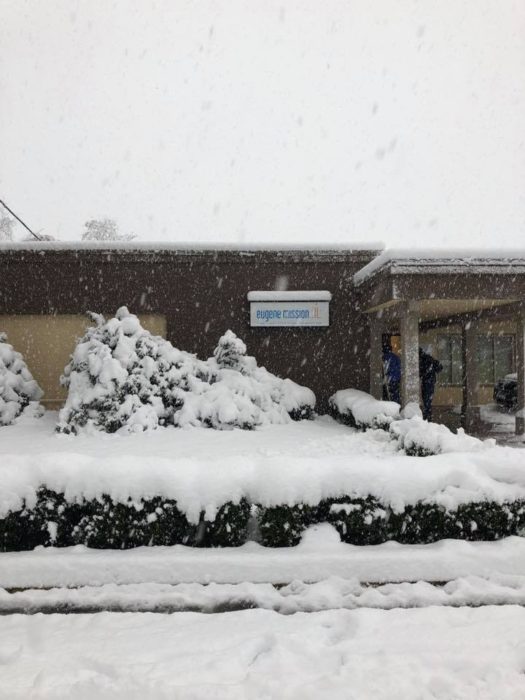
On a cold December night in 2008, Thomas Egan died from exposure on the streets of Eugene, Oregon. The Army veteran’s death shook the city’s social-service community, and inspired the creation of warming centers in his name that activate across Lane County when temperatures drop below freezing. These centers, as well as other overnight shelters, kept homeless people safe and warm during snow storms last week that dropped more than a foot of snow in Eugene.
“We had about 500 unsheltered, very, very wet, vulnerable people,” Windy Dayton, director of Egan Warming Center, said. With libraries closed and public transportation disrupted, the Egan center at Trinity United Methodist Church was a hive of activity Friday night. Volunteers scurried around the kitchen preparing for doors to open; one worker joked that he couldn’t remember what day it was.
The storm exhausted the centers’ supply of clothes, medical supplies, and care packages. A similar scenario happened at the Eugene Mission, a permanent shelter for people experiencing homelessness.
“It was really all-hands-on-deck kind of emergency mode,” said Tabitha Eck, community engagement manager of the Eugene Mission. The shelter saw hundreds of homeless people utilize its services, which include a hot meal, warm clothes, and a bed for the night. The influx of people during the storm depleted the shelter’s supply of men’s underwear, boots, and jeans.
“We buffer it with our budget when we need to, but this isn’t a big budget,” Eck said. The Mission operates on roughly $5 million a year, and about $2 million of that comes from in-kind donations.
There were an estimated 1,641 people experiencing homelessness in Lane County in 2018, according to the Annual Homeless Assessment Report to Congress, and a snowstorm poses significant risks to their health and survival. Beyond the obvious hypothermia and exposure risks, snowfall in this part of the West disrupts government and nonprofit operations homeless individuals rely on. For most, a closed library or canceled bus route is an inconvenience; for those without shelter, it can have a major impact on their health. No fatalities were reported in Eugene, but other snowstorms in the Northwest took their toll. In Tacoma, Washington, a man died, covered in snow, near one of the city’s busiest districts; in Seattle, another died of exposure at a light-rail stop.
Last week’s storm took the Egan centers by surprise, Dayton said. The warming centers only open when the weather is forecast to drop below 30 degrees; because of that, they didn’t open on Sunday the 24th, she said, even though it snowed 14 inches. They’re now re-evaluating that policy.
The centers rely almost entirely on donations and volunteer support, making it difficult to open on non-freezing nights. The week was an eye-opener for the center, Dayton said, but the centers managed to stay open and no one was turned away.
Oregon Governor Kate Brown declared a state of emergency for 10 counties, including Lane, on Thursday. The move freed up some state money for shelters, but it’s unclear how and when that money will be distributed.
And, even though the snow has stopped falling, demand at shelters remains high as the temperatures stay low. “[For] all of us folks with homes, life’s gonna really improve,” Dayton said. “But that won’t be the case here.”
This story originally appeared in the Bitterroot newsletter.
